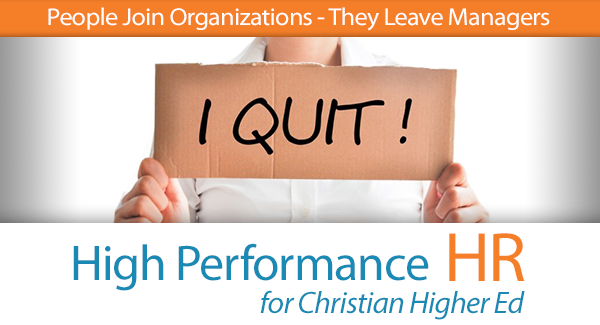
Aug 12, 2019
Do you wonder why good employees leave your organization?
Dr. John C. Maxwell gives his opinion about this in his book Leadership Gold: “People quit people, not companies.”.
My conversation with a young professional twenty-something started simply enough.
“How’s the new job going?”
My eyes widened as I listened to this passionate young lady talk for more than half an hour about how she and many of her colleagues want so much to impact the organization they work for, but how management there is weak and how the leadership completely lacks direction. People are not held accountable, she explained. There is no collective vision as a team and new folks are not brought on board with any sense of excitement or motivation.
I nodded. I knew exactly what she was talking about. I’d seen it for myself in many instances. Eliminating the kind of frustration she was feeling is one of my greatest motivators in doing what I do, helping leaders move forward and build high-performance organizations.
So, what’s going to happen? It wasn’t hard to figure out. She made it quite clear—she won’t put up with it for much longer. Instead, she would become one of the many sharp, smart people I’ve encountered who choose to exercise their skills in more fertile fields instead of enduring such barren conditions. They go on to positively fertilize other organizations, contributing to a sustainable harvest by taking them to greater levels of efficiency and performance.
Meanwhile, those organizations with chronically weak and mediocre managers fade, eventually cease to operate, and die. Maybe not right away—it may take time, but ultimately they fail to survive.
If your organization has great leadership, is on the ball, and inspires and motivates all of its employees, including its young All-Stars, then you are indeed building a high-performance organization.
___________
In His Name HR helps organizations build high performance Human Resources programs. Visit them at In HIS Name HR or e-mail them here.
Mark A. Griffin is the founder and chief consultant of In His Name HR LLC. Connect with him on LinkedIn or Twitter.
Mark A. Griffin | Christian Higher Ed HR
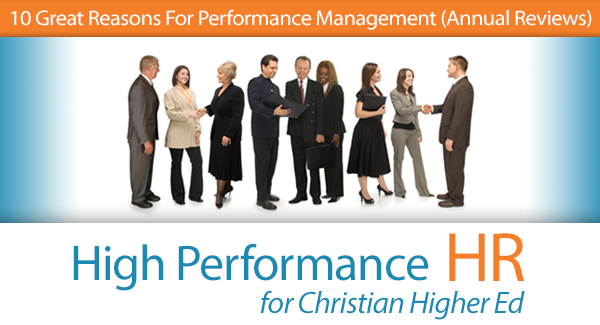
Jun 18, 2019
Most employees loath them; many managers avoid them. High Performance Organizations have them, and they do what they’re designed to do—evaluate precisely the performance of each employee.
Feel like you don’t need them? Here are 10 great reasons that should change your mind.
- Aligning performance to goals and objectives
Most organization employees I meet with say they have no idea what the yearly top two or three goals are for their organization. A great performance program sets these goals as their starting point. Ninety-nine percent of employees in this country want to do well at work, but we lack leaders who know how to align their desire to achieve to the organizational goals.
- Providing a basis for promotion/transfer/termination
Many organizations are not transparent concerning how to be promoted. A performance review process more readily identifies those employees who deserve promotion and those who require lateral shift (transfer) or need to enter into a remedial program. This system also aids career planning.
- Enhancing employees’ effectiveness
Most people really do want to be better at their jobs! Helping employees to identify their strengths and weaknesses and informing them of the organization’s expectations concerning their performance helps them to better understand the role they play and increases work efficiency. Feedback reinforces good performance and discourages poor performance.
- Aiding in designing training and development programs
Instead of creating “programs of the month,” you can use performance review data to more accurately ascertain training needs and identify skills that need to be developed in order to tailor-make the most effective training and development programs.
- Building teams
Counseling employees corrects misconceptions, which might result in work alienation. Performance management also helps employees to internalize the norms and values of the organization. (I have met leaders who have not talked to their employees about their performance since 2012!)
- Removing discontent
Performance management puts all employees on the same measuring tape. Identifying and removing factors responsible for worker discontent motivates them to perform better at work. Performance management helps to create a positive and healthy work environment in the organization.
- Developing interpersonal relationships
Relations between superiors and subordinates can be improved through the realization that there exists a mutual dependence that leads to better performance and success. By facilitating employees to perform introspection, self-evaluation and goal setting, their behavior can be modified. Better interpersonal relationships lead to team building.
- Aiding wage administration
Performance management can help to develop fair and more equitable base lines for reward allocation, wage fixation, raises, incentives, etc.
- Exercising control
A performance review process provides a means to exercise control of projects focused on, and helps keep employees aligned to the agreed upon annual goals and objectives.
- Improving communication
Performance management serves as a mechanism for improved communication between superiors and subordinates. Often times managers shy away from counseling employees. When the right system is in place, especially is it is employee driven, it forces discussions on a regular basis.
In closing, my experiences lead me to support employee driven programs. Programs that rely on managers and leaders have a higher propensity for failure. Simple yet meaningful programs that include goals, objectives, behaviors, an employee development component and stretch assignments meet what most employees’ desire.
How important are employee performance reviews in your organization? Leave your comments below!
___________
In His Name HR helps organizations build high performance Human Resources programs. Visit them at In HIS Name HR or e-mail them here.
Mark A. Griffin is the founder and chief consultant of In His Name HR LLC. Connect with him on LinkedIn or Twitter.
Mark A. Griffin | Christian Higher Ed HR
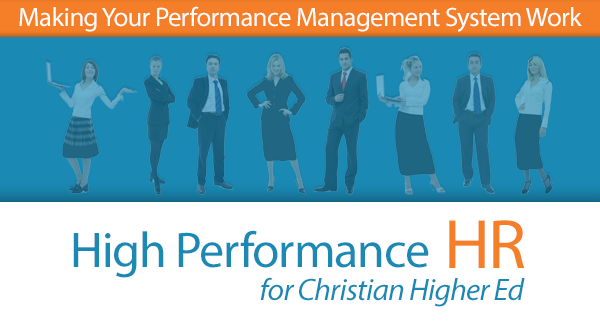
Sep 24, 2018
Poor employee performance hurts an organization. Low productivity, incompetence, and unneeded expenses are the last thing organizations want at any time, particularly in today’s tough economy.
After decades of work in the field of business and human resources, I know that few things upgrade and energize an organization like a solid Performance Management System. A performance management system incorporates your organization’s Mission, Vision and Values as well as your annual goals and objectives to create the structure and accountability by which an employee can accomplish these goals and objectives and, more importantly, improve their lives. Only the highest-performing organizations make the performance review process a valued, appreciated, and eagerly anticipated system for the both organization and its employees.
Instead, what usually happens?
Sadly, many organizations do not systematically review or improve employee performance at all! This leads not only to unmet expectations from the management’s point of view, but also creates confusion and frustration for employees. The result is poor performance and money down the drain. Other times, organizations attempt to implement a yearly review but end up doing it backwards and it becomes counter-productive. This article will teach you how avoid this pitfall.
Have you ever weathered “The Dreaded Annual Review Meeting?”
Television and film have lampooned the phenomenon, highlighting the common foreboding employees feel and the waste of time such a meeting can be. How can you implement a Performance Review System that will consistently improve employee productivity and competency, save costs, and have eager employees lining up for it?
Start by avoiding these two biggest, most critical mistakes…
Mistake # 1 The leader fails to include input and participation of the employees at the beginning of the process.
The best performance programs are employee-driven. The leadership works in a “guide and support” role. This is a significant shift, but one that can make or break your organization. When the process of improvement and review is centered on and driven by the employees, it creates an emotionally potent sense of ownership and cooperation. Instead of being hounded and rebuked by a controlling boss, the employee is the source of increased performance through an active and vested role.
It behooves an employee to generate high performance and a good system will take this into account by providing employees the dignity of being responsible to see the improvement process through to the end. The performance program should encourage and reward employees who initiate performance conversations with management. A program executed well will encourage the employee to want to do better as he/she makes the efforts necessary to ensure it happens.
Mistake #2 Leaving out personal development.
Never forget the vital career development component. A simple career development piece can do wonders for employee morale and can be easily built right into your performance program. Employees naturally want to improve their lives and better their circumstances. A career development component helps employees know, envision, and subsequently achieve promotions, positions, and greater responsibility within your organization.
A career development focus gives the employee the opportunity to take ownership of their career destiny.
A good career development component helps the employees ascertain what they need to do to close the gaps in their experience and education in order to be promoted to other positions. Many great programs include education and seminars, but some cleverly include short-term assignments in other positions to gain vital hands-on experience.
Implementing a proper performance program may seem daunting, remember that employees are not just your greatest assets; they are the key to ensuring that you can thrive in challenging economic times.
___________
In His Name HR helps organizations build high performance Human Resources programs. Visit them at In HIS Name HR or e-mail them here.
Mark A. Griffin is the founder and chief consultant of In His Name HR LLC. Connect with him on LinkedIn or Twitter.
Mark A. Griffin | Christian Higher Ed HR

Apr 2, 2018
Huge changes in the labor force draw near. Here’s how to get prepared!
Baby Boomers are a very influential demographic of people born after World War II, in the years 1946‒1964, and will soon represent a whopping 40 percent of the workforce. In 1950, only one in six workers were over the age of 55. In less than two decades, one of every four workers will be over age 55. Multigenerational organizations are now the norm, with many organizations employing people who are in their sixth or seventh decade of life.
The impact is enormous. It will continue to affect the workplace everywhere in the U.S. Some Boomers plan to retire, leaving giant gaps and a vortex-style “brain drain” across most industries. Others will stay working or shift to part-time employment, creating new challenges most organizations are unaware of or unequipped to handle. Either way, the costs could be devastating, so preparing now is crucial.
Activate These 3 Concepts to Avoid Trouble:
(1) Retention
Economic woes have resulted in most Boomers not being ready for retirement at the normal age range of 62 to 70. The AARP reports that a full 25 percent of Boomers have no savings on which to retire whatsoever, and a mere 14 percent plan to retire when the time comes. Nevertheless, only 52 percent of organizations have policies to rehire retired workers. Ensure that your organization is ready for this inevitability.
(2) Train for the Talent Gap
Many Boomers have vast working experience, crucial expertise, and command top pay. Too few organizations are utilizing Boomers to train younger workers while they are still around. Job mentoring, job shadowing, and job sharing with younger workers are three important options to make the transition less painful. Move quickly to create programs to train younger workers alongside Boomers before it’s too late. Additionally, more sophisticated recruitment and hiring programs are needed to find qualified and competent talent in a shrinking pool with a wider age spectrum.
(3) Accommodate
Most organizations are not prepared to accommodate aging workers; so work-related disability claims are expected to rise sharply. That’s expensive! Take steps now to create a safe and accommodating work environment to avoid injuries and to make working less stressful for an older workforce. A Human Resources consultant can assess what changes are necessary to avoid workplace injuries and boost morale.
Those Boomers who want to continue working often face discrimination and prejudice. In truth, this population typically comprises excellent workers who are far more flexible, able to learn, and more technologically savvy than the persisting stereotype would have us believe. Plus, employment laws protect them against unfair hiring practices. Avoid lawsuits and potential problems by knowing the law and complying with it. If you have not read this article regarding HR legal compliance, please do so.
According to the Sloan Center on Aging and Work, organizations can do a lot to ensure that Boomers work to an older age and do well on the job. Flexible work options, participation in decisions, chances to develop new skills and competencies, and regular engagement will help Boomers succeed in your organization for years to come. By valuing them properly, you will mutually reap the rewards.
As the demographic shifts, many organizations will experience disruption or harm—but it doesn’t have to be your organization! Right now is the time to make sure that you are prepared for the biggest demographic shift in the history of American labor.
______
In His Name HR helps organizations build high performance Human Resources programs. Visit them at In HIS Name HR or e-mail them here.
Mark A. Griffin is the founder and chief consultant of In His Name HR LLC. Connect with him on LinkedIn or Twitter.

Mark A. Griffin | Blog, Christian Higher Ed HR
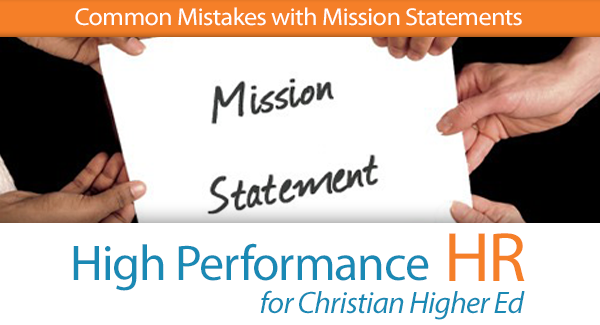
Jan 9, 2018
When organizations want to perform at the highest level, they leverage the three (3) commitments that strengthen their organization like a strong, cement foundation:
Mission Statement
Vision Statement
Core Values
With these in place, everyone in the organization starts out on the same page. Better yet, clients and customers know what to expect and it builds additional trust. They appreciate the organization’s investment and articulation of these commitments.
However, it’s not as simple as punching out three sentences to propel your organization forward. There is an important process to creating potent organizational statements to ensure they truly succeed.
Today, we’ll look at the 4 mistakes commonly made during the creation of an organization’s Mission Statement. Done poorly, a Mission Statement can actually undermine the high performance leadership hopes to attain in the first place.
Don’t let this happen to you!
Mistake #1: Not including employees in the process.
When leadership creates a Mission Statement in a vacuum, employees are far less likely to appreciate it, accept it, and, most importantly, execute it.
Instead, your organization should first get input from a group of employees that make up a good cross-section of capabilities and responsibilities throughout the organization.
At this point, too many organizations find that employees have little idea what their organization really stands for or why they are doing what they do. Unless you’ve clearly articulated a Mission Statement, you can’t blame them. After employee input, the leadership can approve and improve on what comes from the employee input group.
With a Mission Statement in place, employees do more than just show up. They arrive to work with a renewed orientation to the organization and feel like they are doing something meaningful. Everyone wants to play a part in something bigger than just themselves. A Mission Statement gives them this opportunity.
By including them from the start, employees not only start to think from a high-performing standpoint, but they also feel respected and appreciated for their input at the outset.
Mistake #2: Creating a Mission that is too broad or too lofty.
Here are examples of two Mission statements that don’t work:
“We want to make the world a better place.”
“We want to give our customers good service and a great price.”
Compare them to one from Charity Water. It gets to the crux of their mission.
“We’re a non-profit organization on a mission to bring clean and safe drinking water to every person on the planet.”
Or, this great example from Habitat for Humanity International:
“Seeking to put God’s love into action, Habitat for Humanity brings people together to build homes, communities and hope.”
Mistake #3: Not rolling out the new Mission appropriately.
A good Mission Statement is woven into the very culture and fabric of your organization. It’s not just something that goes on the wall and the website. It gets incorporated into all the material of your organization.
During your hiring practices, organizational meetings, performance reviews, and in job descriptions, you should have direct tie-ins and references to your Mission. After all, your organization is centered on a Mission: its purpose for existing.
EXPERT TIP: Your employees are great idea factories to help find new ways to proliferate and enact your organization’s Mission statement in multiple ways that will make a big difference. Get their input.
Mistake #4: Not communicating the Mission to your key stakeholders.
Your key stakeholders are your students, parents, vendors, and suppliers. Your Mission statement should be integrated into your interaction with them, and in all the material, marketing, and communications you engage in together.
Your Mission Statement is the central feature around which your organization revolves. That means, it’s not just an internal document. Make sure you publicize it, every chance you get.
You don’t have to tackle the process of creating a Mission Statement alone. You can hire an outside HR expert to guide you. There are other helpful HR resources too, like the HR Mastery Toolkit we have created to make your organization high-performing in this and other areas. It teaches and guides you in the best practices of some of the top, most effective organizations in the world.
When you create a Mission Statement using a top-notch process, you’ll find that performance on every level improves. Not only do you save costs and improve quality and productivity, but also being employed at your organization becomes much more enjoyable.
In our next post, we will continue examining this critical trio. I’ll give you some of the expertise I’ve gleaned from more than twenty years in the field of human resources. Come back to read: 3 Mistakes in High-Performance Vision Statements
___________
In His Name HR helps organizations build high performance Human Resources programs. Visit them at In HIS Name HR or e-mail them here.
Mark A. Griffin is the founder and chief consultant of In His Name HR LLC. Connect with him on LinkedIn or Twitter.
Mark A. Griffin | Christian Higher Ed HR

Nov 27, 2017
Finding and keeping qualified talent has never been more challenging or expensive. Too many organizations implement haphazard hiring methods that are not only inefficient, but also potentially illegal.
Are people hired systematically at your organization?
The best organizations in the world use sophisticated processes to find and hire new workers. If you don’t have a solid system in place to hire workers, consider creating policies, and putting them in writing, that outline your process in detail.
Ready to get started?
Here is a checklist of 4 action steps that you should ensure your HR department is following. By using these steps they will simplify the hiring process for your organization.
Step 1 – Create a candidate pool by…
- Constructing a comprehensive job description (with employee input)
- Having leadership approve the position and salary range (based on a compensation study)
- Posting the position internally first, to allow current employees the opportunity to apply
- Encouraging employees to refer friends and family
- Creating an advertisement based on the established job description
- Running the advertisement
- Reviewing ad responses against the requirements outlined in the job description
- Sharing your Mission, Vision and Values (MVV) with all candidates
- Having the candidates explain how they will support your MVV
- Setting up three to four candidates for interviews
Step 2 – Systemize the interview process by…
- Selecting interview questions and job criteria correlated to the job description requirements (build MVV questions into process)
- Requesting all interviewees first fill out an application
- Ensuring all interviewees sign a “consent to background check” form
- Having interviewers complete a Candidate Evaluation Form on every candidate after each interview.
Step 3 – Establish the Selection Process by…
- Having the team of interviewers meet to discuss candidates (this is typically led by HR personnel)
- Conducting candidate interest testing (be careful with tool used)
- Selecting the best candidate based on interview results, selection testing, and the hiring manager’s decision
- Furnishing a verbal offer to the candidate and, if agreed to, creating an offer letter
- Sending the offer letter for the candidate to sign, and ensuring it is returned to you.
Step 4 – Start the hiring process by…
- Sending the application and consent form to a background check company
- Arranging a pre-employment physical and drug & alcohol test for the candidate
- Setting a firm start date when the candidate has met all the requirements and is determined “all clear”
- If the candidate fails the background or D&A test, the candidate is notified by HR and you return to initial pool of interviewed candidates, choose one, and begin the hiring process again or expand the candidate pool and begin again.
- Sending out polite non-selection letters to the other candidates
When you implement a consistent system in your hiring practices, you will increase the efficiency of your organization, saving time and money, and eliminating confusion, both now and in the future.
Also consider the fact that by using the right recruitment approach you are also marketing your organization to potential students?
Any dollars spent in recruitment marketing also benefits your institution from a brand recognition perspective.
___________
In His Name HR helps organizations build high performance Human Resources programs. Visit them at In HIS Name HR or e-mail them here.
Mark A. Griffin is the founder and chief consultant of In His Name HR LLC. Connect with him on LinkedIn or Twitter.
Mark A. Griffin | Christian Higher Ed HR
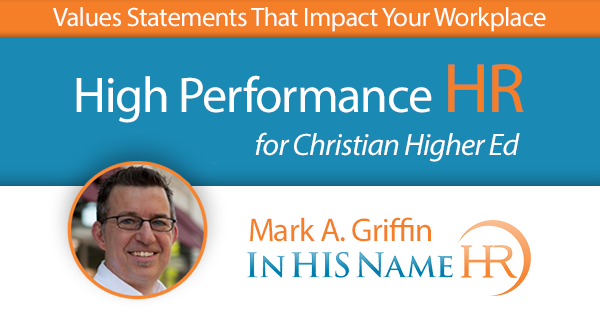
Oct 3, 2017
The third ingredient of MVVs is values, specifically core values. A core value, from a human resources perspective, reflects the heart of an organization. It pumps the blood throughout; it makes an organization tick. It defines the organization and its culture and what it takes pride in doing. It is how vendors and customers view an organization’s behavior toward them. It is what employees tell their neighbors and friends when asked what it is like to work where they do. It is why your students choose your college. It is the behaviors your staff and instructors exhibit as they
In the secular world an organization focused on quality might state its core value as: We do not compromise on quality. Quality is job one. An organization valuing individual responsibility would want to say: We believe in holding ourselves accountable. We deliver on our promises and we always endeavor to use good judgment. Efficiency, honesty, customer service, ownership—these and many more reflect the kinds of core values that high-performing organizations embody.
In order to enjoy growth and prosperity and achieve high performance, an organization must first look inward and thoughtfully address these three critical aspects of running an organization. Those that invest in a well-developed and bought-in mission, vision, and values will reap dividends far beyond those that do not.
As leaders at Christian colleges and Universities, we take a Biblical/Kingdom approach to our Mission, Vision and Values creation. Often times it is best to cite a bible verse to stir commitment and affirmation as to why the value is important.
In doing research we discovered Ozark Christian College’s Values Statement. Enjoy reviewing and reflecting how your Values statement might be updated or recast to create excitement on your campus.
CORE VALUES
THE WORD OF CHRIST TAUGHT IN THE SPIRIT OF CHRIST (COLOSSIANS 1:28)
We believe the Bible is the true and authoritative Word of God and our final rule of faith and practice. We want to teach God’s Word faithfully, in harmony with God’s Spirit.
NOT TO BE SERVED BUT TO SERVE (MARK 10:45)
We are a servant of the church, training vocational and volunteer servant leaders for the worldwide work of ministry. It is the commitment of teachers, staff and students that we will love and serve others.
SPEAKING THE TRUTH IN LOVE (EPHESIANS 4:15)
We want to honor God by fulfilling our personal responsibility to be honest and caring with one another.
TRUSTING IN THE POWER OF GOD AND SEEKING THE GLORY OF GOD (1 CORINTHIANS 4:20 & ISAIAH 42:8)
We are absolutely and utterly dependent upon God. The work is too great for human resources. We pursue excellence, knowing all glory is God’s and any accomplishment is of him.
ATMOSPHERE OF GRACE, TRUST AND FREEDOM (ROMANS 15:7 & 1 PETER 4:10)
We accept one another as imperfect people saved by the grace of God. Mutual trust, based on our commitment to the Lord, guides our relationships. We desire each person to have freedom to develop God-given gifts.
RESTORING BIBLICAL CHRISTIANITY (JOHN 17:21)
We are committed to teaching and practicing biblical Christianity, believing it is central to unity among believers and evangelization of the world.
WORSHIP IN SPIRIT AND TRUTH (JOHN 4:23-24)
We foster spiritual health through genuine worship, both personal and public. Worship is for the glory of God, exhortation from his Word, and edification of the community of faith.
___________
In His Name HR helps organizations build high performance Human Resources programs. Visit them at In HIS Name HR or e-mail them here.
Mark A. Griffin is the founder and chief consultant of In His Name HR LLC. Connect with him on LinkedIn or Twitter.
Mark A. Griffin | Christian Higher Ed HR
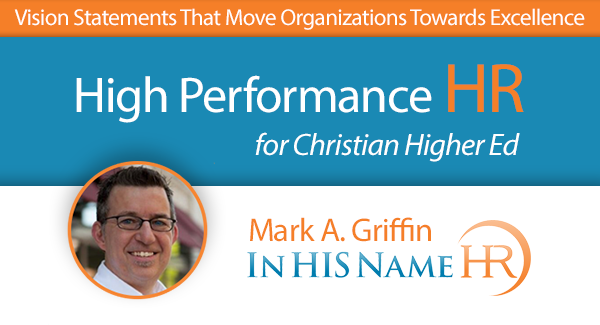
Sep 20, 2017
Vision statements should consider how the market and your customer base may change within the next three, five, or seven years, how such changes can create opportunities for your organization, how to bridge the distance between how things are today and where you envision you want to be within your established timeframe, how you will surpass your competitors in order to gain greater market share, and also what you are doing collectively to capitalize on the changes in business conditions and your business’s needs.
Like a mission, an organization’s vision has ideally been created/ contributed to by all employees. The more buy-in an organization has among its employees, the greater the effectiveness of the vision. The vision should inspire—it demonstrates where the organization as a whole wants to be, and what will occur as it delivers on its mission. It is where an organization envisions itself in those three, five, or seven years. (We prefer five years, because that is a reasonable amount of time for most organizations to get to the next step.)
So, whereas the mission is what an organization does best every day, its vision is what the future looks like when it fulfills its mission exceedingly well. Some effective vision statements include Nike: To be the number one athletic company in the world, and Amazon: Our vision is to be earth’s most customer-centric company; to build a place where people can come to find and discover anything they might want to buy online.
When I worked for Gatorade, we developed an incredible advantage over the competition because we took the time to establish its vision, where they were going and when they wanted to get there, and ensured that every employee shared this vision. Gatorade’s competitors at the time, Powerade and All Sport, faded away as a result, because they lacked a commonly shared vision, they lacked direction—they lacked a road map.
___________
In His Name HR helps organizations build high performance Human Resources programs. Visit them at In HIS Name HR or e-mail them here.
Mark A. Griffin is the founder and chief consultant of In His Name HR LLC. Connect with him on LinkedIn or Twitter.
Mark A. Griffin | Christian Higher Ed HR
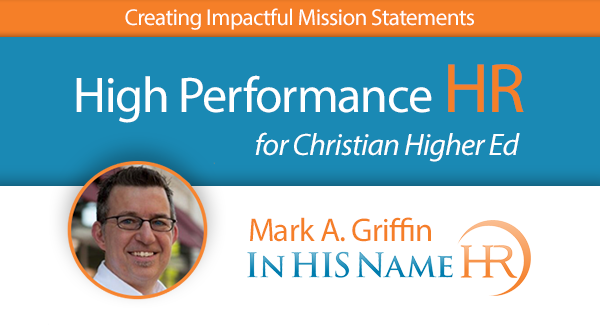
Sep 5, 2017
Successful organizations begin by establishing their mission, which is the core reason for their existence—the product or service they provide, who they provide it to, and the benefits of that product or service. A lack of an established mission means that not only are staff and management unsure of their purpose, but customers and vendors are also left in the dark, uncertain of what to expect.
An organization’s mission ideally defines what it does best every day and why, and reflects the customer’s needs as well. Having a mission is the foundation upon which a high-performing organization’s dreams and potential become reality. Essentially, it affirms the reason(s) why an organization exists.
Under the guidance of a project facilitator, a team of senior management begins by developing a framework of what they believe the mission should be. The facilitator shares and explains this mission framework to each supervisory layer, soliciting input on each occasion, and ultimately shares it with the employees who then sit down with a good human resources representative in a roundtable session to discuss it and generate further input. The facilitator may need to go back and forth a few times before a final product is derived. Once the majority of employees and management agree to the refined mission, all employees need to agree to respect and support it.
A primary benefit to creating or revisiting a mission is that it opens up communication within and throughout an organization. Every successful organization has a clearly established mission, one that has been developed with input from all employees collectively, not simply flowing down from the top. By engaging employees in establishing their organization’s mission, they become fully invested in it. The mission must be ingrained within the organization’s culture. Not only are employees and customers made familiar with the organization’s mission; candidates are also exposed to the mission of high-performing organizations during the interview process, before they’re offered a position.
Some tips to remember when writing a mission statement: 1) keep it short and easy to remember; 2) specify who your target customer is and describe the advantages you offer; and 3) define your product clearly and how it differs from the competition.
You may be wondering how you can say all that and still keep your mission statement short and memorable. Here are two strong examples from high-performing organizations with effective mission statements.
Google: We organize the world‘s information and make it universally accessible and useful. Their marketplace? The world. Their product and its advantages? Organizing the world’s information to make it easily accessible and useful. They do this and they do it exceedingly well.
Starbucks: We inspire and nurture the human spirit — one person, one cup, and one neighborhood at a time. Their marketplace? Also, essentially the world, yet they stress the individual: one person, one neighborhood at a time to maintain a personal feel. We are already very familiar with their product and social coffeehouse environment, aren’t we?
Let’s look at a Bible College and Seminary Mission.
Lancaster Bible College|Capital Seminary & Graduate School: Our focus is on your journey to fulfill God’s purpose for your life. Our mission has remained constant since 1933: To educate Christian students to think and live a biblical worldview and to proclaim Christ by serving Him in the Church and society.
And finally a Private Christian College.
Messiah College: Our mission is to educate men and women toward maturity of intellect, character and Christian faith in preparation for lives of service, leadership and reconciliation in church and society.
In addition to a mission statement, all high-performing organizations possess a clearly defined vision. Organizations with an established vision have a workplace of direction, purpose, and achievement. These organizations envision where they want to be and do the appropriate things to get there. Every employee is given a copy of this road map.
In His Name HR helps organizations build high performance Human Resources programs. Visit them at In HIS Name HR or e-mail them here.
Mark A. Griffin is the founder and chief consultant of In His Name HR LLC. Connect with him on LinkedIn or Twitter.
Mark A. Griffin | Christian Higher Ed HR
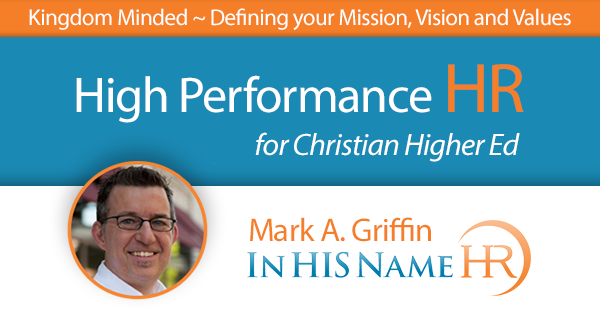
Aug 21, 2017
When we meet with people to discuss strengthening their HR practices, we often use the term “Kingdom-minded organization.” More often than not, they are intrigued as to precisely how we define what potentially encompasses a considerably broad scope or approach. Certainly, many Christian business people, academia professionals, pastors, and consultants have their own ideas as to what constitutes a Kingdom-minded organization. My own Kingdom-minded human resources organization has worked hard to develop what we feel is a clear, actionable, and measurable articulation of just what a Kingdom-minded organization means to us and how to achieve it, and, as a result, the organizational leaders we work with express enthusiasm to achieve these goals, and are willing to invest their precious time, dollars, and energy into making their organization a prosperous one, and one reflective of Christ and His teachings.
In terms of what comprises the framework of a Kingdom-minded organization, the model I developed contains principles that apply to marketplace organizations, colleges and universities, churches, and non-profit organizations alike.
A Kingdom-minded organization puts Christ first, with a focus on integrity, honesty, and straightforward dealings with students, alumni, parents, staff, contractors and suppliers, etc. Such an organization possesses clearly delineated mission, vision, and core value statements. It has agreed upon goals and objectives, especially in the realms of mission execution, customer service, production, and quality.
Being a Kingdom-minded organization does not in any way preclude prosperity. On the contrary, it aims to be prosperous for the benefit of its key stakeholders, leadership, owners, employees, and the organization’s community. They should—they must—strive to do great things, marrying their godly goals with the fruits of success, those of a job well done. By no means should they consider themselves as unable to participate in the results-driven culture of winning U.S. organizations.
Mission, Vision, And Values (MVV)
When mapping out the future of an organization that professes to strive to become high performing, management must create its mission, vision, and value statements (MVVs) or ignite existing ones by recreating them. Much has been written on what should comprise mission, vision, and value statements. I always suggest keeping them simple—simple concepts that all employees can remember and fully support. It’s difficult to fully commit to and “own” an organization’s ideals if they are so complicated, convoluted, or vague that the employees can’t remember them clearly.
___________
In His Name HR helps organizations build high performance Human Resources programs. Visit them at In HIS Name HR or e-mail them here.
Mark A. Griffin is the founder and chief consultant of In His Name HR LLC. Connect with him on LinkedIn or Twitter.
Mark A. Griffin | Christian Higher Ed HR











